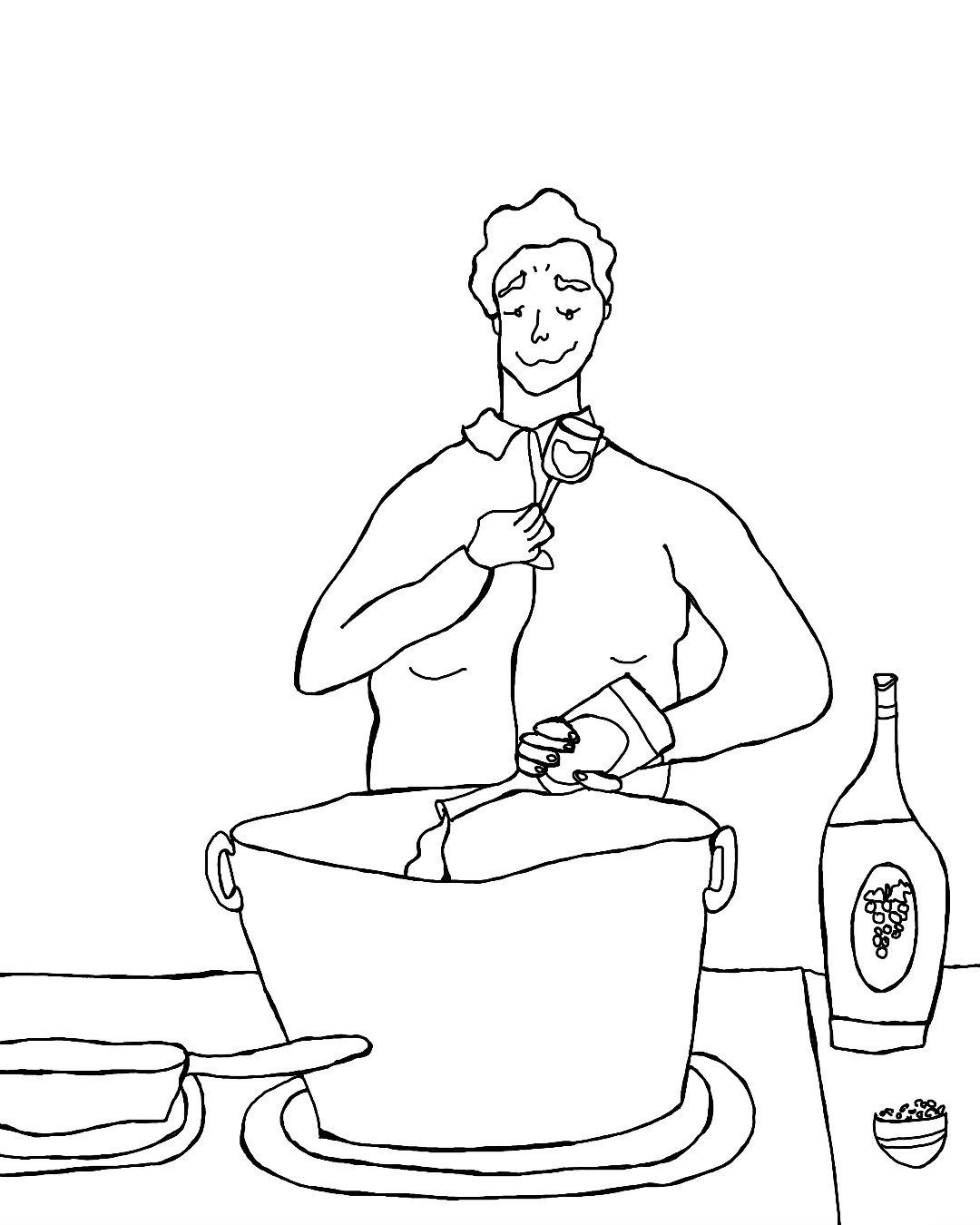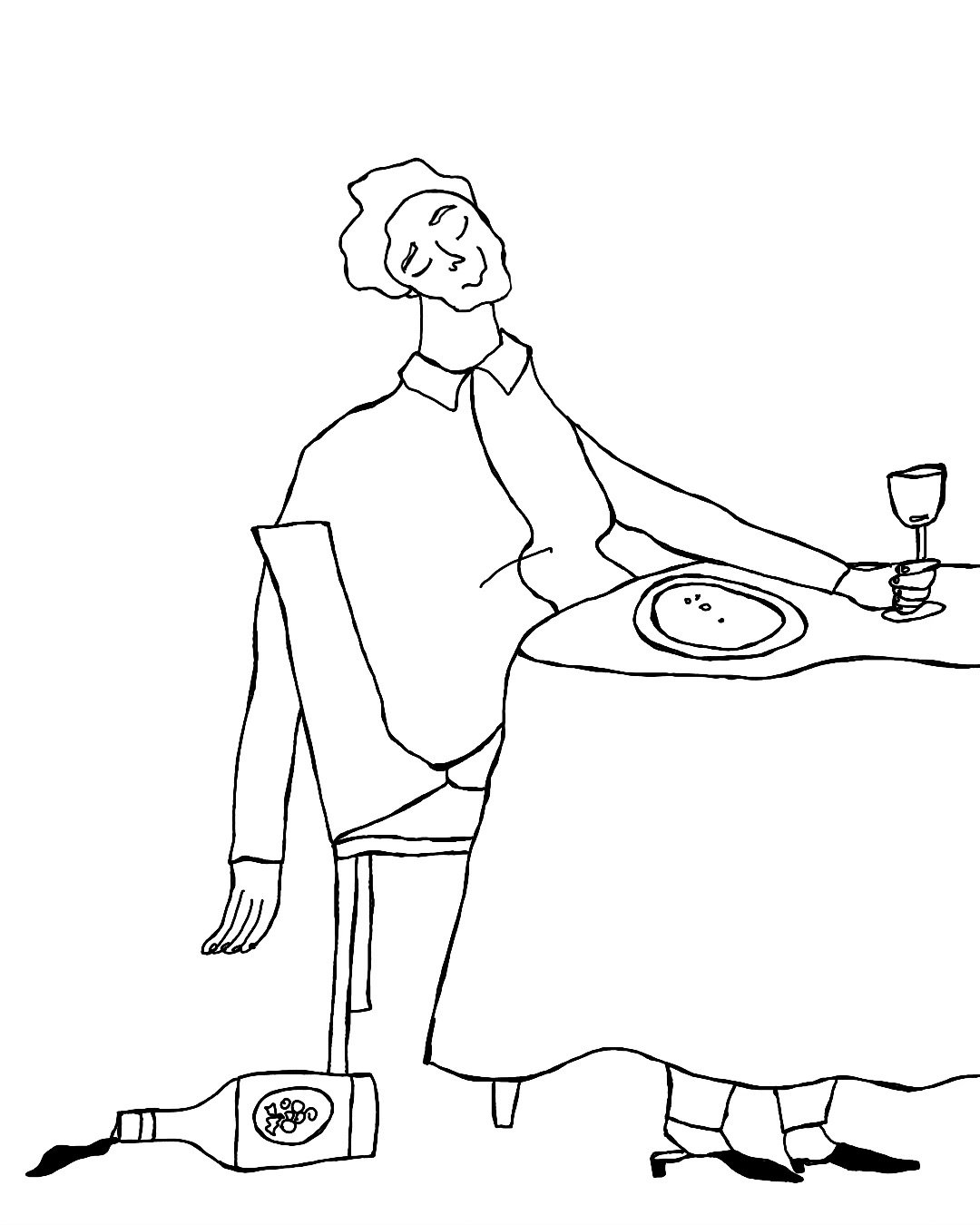Is It a Waste to Cook with Wine? What Chefs & Wine Experts Really Think
When to use wine in your cooking, how much it matters, and why it’s not always about the price tag.
Written by Aisha Catena
Illustration by Cerise Zelenetz
Cooking with wine can be confusing for the average home cook—which wines should you use? Does the price matter? Will the flavor actually come through? The idea of pouring a glass—or even an entire bottle—into a pot, only for it to reduce, cook, and evaporate, might make you think twice. Not just because that bottle could cost $20, but because it’s hard to know if it’s actually doing anything in the dish.
There’s a good chance a tremendous amount of effort went into creating that bottle of red stirred into a ragú or that crisp, acidic white used to steam clams. The vine flowered. The grapes ripened, were harvested, crushed, and fermented, then left to rest, all to develop a distinct color, aroma, and flavor. So much work, only for the wine to seemingly disappear into the dish.
So why do chefs and home cooks alike reach for wine, sometimes in small splashes, other times by the bottle, when cooking?
“Wine offers a variety of complex flavours that transfer to the food: acidity, sweetness, minerality, citric, fruity notes, and more,” says Isabella Bartorelli, chef and founder of Yo Tambien Cantina in San Francisco.
Illustration by Cerise Zelenetz
Wine is often described through five primary organoleptic components: alcohol, acidity, sweetness, tannins, and aroma, each contributing to how it tastes, smells, and feels in the mouth. The pulp of the grape provides sugar, acidity, and flavor; the skins, stems, and seeds contribute tannins; fermentation introduces alcohol and balance. Through winemaking, all of these elements come together to create a delicious, one-of-a-kind drink—or, for our purposes, a one-of-a-kind ingredient.
Few ingredients bring together such a range of complex, distinct flavors in one place. Mia Glickman, research and development chef at Achilles Heel in Brooklyn, New York, explains how wine’s uniqueness plays out in the kitchen: “Wine can cut the fattiness of bigger cuts of meat... If I start with a good amount of wine and let it cook along with the meat, the acidic qualities will mesh with the richness... Wine adds that specific, mellow complexity. It’s sweeter than vinegar, softer than lemon juice, way more complicated than broth.”
Wine can also give cooks more control over a dish, allowing them to spotlight a specific flavor that might otherwise get forgotten. Eric Moorer, Wine Director of Gemini in D.C., illustrates this with a dish where he wanted to elevate the flavor of caramelized onions. He chose a Riesling—something slightly sweet, with citrus and stone fruit notes—to bring out the onion’s depth. “We're building around [the sweetness] to add more layers to the onion, for lack of a better phrase,” he shared with a laugh.
With wine often glamorized as a hero ingredient, it’s reasonable to wonder: Do I need to cook with high-quality, expensive wine to get the same effect? First, it’s worth separating quality from price—not all quality wines are expensive, and not all expensive wines are quality.
Isabella has a clear view on the matter: “The quality of a dish is a reflection of the combination of ingredients and the technique of how those ingredients relate to each other through cooking.” If you’re using fresh, local ingredients, you might consider choosing a wine made with a similar philosophy. The classic idea that “if it grows together, it goes together” doesn’t just apply to pairing—it can also guide how you select wine for cooking. “In my opinion,” Isabella adds, “the execution of a good dish has to do with what’s available in the place where it’s cooked or consumed. If you don’t have access to high-quality wine, you can use what’s available instead.”
Illustration by Cerise Zelenetz
Let’s say what’s available to you is whichever bottle is under $10 at the corner bodega—will that actually affect the taste of your dish? According to Jack Fatheree, General Manager at Piccino Presidio, not significantly. “It has more to do with the nature of the wine/grape,” he explains. “A dry white wine will help cut through and balance rich dishes due to its acidity, while a sweeter wine will reduce into a syrup that can be used as a sauce for desserts. The nuanced complexities you pay for in a well-made, expensive wine mostly get lost when exposed to intense heat—so it really boils down to the type of wine.”
If you want to keep it real simple, stick to Mia’s advice, “A wine has to be good enough that you wouldn't mind drinking a glass of it as you cook the meal.”
These perspectives don’t contradict each other—they can easily coexist. As long as the wine you’re cooking with isn’t loaded with additives like excess sugar or acid, and it complements your recipe, its quality won’t make or break the dish. But if you’re working with fresh, seasonal ingredients or aiming for something more refined, it’s worth reaching for a wine that reflects that same intention—one made with as much care as the food you’re preparing.
It’s a personal decision, and Eric agrees: “It is 100% about you; if at the end of the day you feel like you did the best that you could with the materials that you had in front of [you], that's a huge win.”
So, where does that leave us? Let’s get to the heart of it: Is it a waste to cook with wine? Should you be savoring it in a glass rather than pouring it into a pan? The simple answer: not at all.
As Eric puts it, “If I were dumping it down the drain, that's a waste, if I were putting it into, like, a f*cking sangria, that's a waste. We're having an entirely different conversation… [The wine you use to cook] It's still part of your consumption… You're not trying to cover anything up in the wine.” Wine adds to your dish, and when used purposefully, you’re simply enjoying the wine through a different medium.
So, how do you choose the right wine for cooking?
Start by thinking about what your dish needs and how wine can help bring that out. For example: braised short ribs call for medium to full-bodied red wine and mussels shine with a splash of dry white.
Ask the experts at the store! Describe the dish you’re planning and they’ll be happy to recommend a bottle that complements it.
Don’t be afraid to get creative. You’re not limited to Eurocentric pairings—explore wines from all over the world and see what sparks your interest.
Or start with the wine. With so many incredible options out there, cooking can be the perfect excuse to open something new—without the pressure of finishing the whole bottle. Pick a wine you’re excited to drink, then find a recipe that lets it shine.



